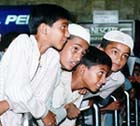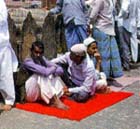What the students are taught and the fashion in which their tender minds are moulded, time seems to have frozen many centuries ago
Mushirul Hasan continues his discussion on the state of Indian Muslims, 50 years after Freedom.
 Much of it, as in Surat or Baroda, is not new. Apart from petty
traders and groups of Muslim artisans who have carved out a place
for themselves, the Bohra, Khoja and Memon communities continue
to play trading and mercantile roles in western enterprise, including
two cotton-spinning mills in Surat stared in 1861 and 1874, Ahmedabad
had no Muslim mill-owners, and only one industrialist, Munshi
Fateh Mohammad Fakir Mohammad, who started a match factory in
1895.
Much of it, as in Surat or Baroda, is not new. Apart from petty
traders and groups of Muslim artisans who have carved out a place
for themselves, the Bohra, Khoja and Memon communities continue
to play trading and mercantile roles in western enterprise, including
two cotton-spinning mills in Surat stared in 1861 and 1874, Ahmedabad
had no Muslim mill-owners, and only one industrialist, Munshi
Fateh Mohammad Fakir Mohammad, who started a match factory in
1895.
The situation improved over the decades because the textile
and transport industries expanded, attracting large numbers of
Muslim migrants into the city. Though still relatively backward
in most sectors of the economy, especially in the professions
and in private and government employment, Muslims in Ahmedabad
have made their mark in textiles, transport, petty trading and
shopkeeping.
The overall progress of the Kerala Muslims is aided by Gulf employment,
reservations in education and higher rates of literacy achieved
through sustained application. Farook College at Calicut in the
Malabar region, from its humble beginnings in 1947-8, generated
constructive movements of modernity and progress among the Kerala
Muslims; it has been called 'the Aligarh of the south.'
Along with other voluntary agencies, the Muslim Educational Society, founded
in 1964, promotes primary, secondary and higher education. By
1960, 46.3 per cent of school-age Muslim children were attending
school; by 1970, Mapillas accounted for 30 per cent of college
students in Malappuram and Calicut districts. At the beginning
of 1974, about 700 lower and upper primary schools and 36
high schools flourished under Muslim management. In the state
as a whole, there were nine first-grade Muslim colleges and several
technical institutions.
The fortunes of the Kerala Muslim migrants to Madras city have
improved since the 1940s when they first entered the metropolis.
Those from the Malabar region did particularly well in running
hotels, biscuit factories, textile concerns and import-export
firms. A Muslim timber merchant who came to the city penniless
now owns one of the largest timber firms in south India with twenty
branches in Madras city.
The Malabar Muslim Association has reason
to be proud of its achievements. It set up a medical relief centre,
primary and secondary schools and colleges. The Islamic Foundation
in Madras founded an engineering college in 1984 in the name and
style of the Saleh Kamel Crescent Engineering College at Othivakam
in Chengalpatlu district. The Al-Ameen Educational Society in
Bangalore founded colleges, an evening polytechnic (1977) and
a school of pharmacy (1982). In 1984 the society awarded scholarships
amounting to Rs 89,745,63.
The picture is much less promising in UP and Bihar. These states
have some isolated pockets of affluence, but on the whole a rather
alarming percentage of the minorities, particularly the poorer
sections among the Muslims, live in these states. The country's
partition and the sheer scale and magnitude of migration of Pakistan
from traditional Muslims centres like Delhi, Aligarh, Farrukhabad,
Moradabad, Rampur, Meerut, Mufaffarnagar, Lucknow and Allahabad
contributed to the professional classes being skimmed off. The
loss has not been made good.
Zamindari abolition caused serious
hardships to small landowners, zamindars and their dependants.
When Hindi was made the sole language of administration and education,
the affected sections were the very ones which sought employment
at the clerical level, in lower government service or in educational
institutions.
Indeed, it was difficult for many Muslims
whose mother-tongue was Urdu to compete for government posts.
This, and the constant fear of discrimination, largely
accounts for so few taking the competitive examinations for government
posts.
Widespread illiteracy and a higher drop-out rate at the elementary
stage are additional factors. According to the Planning
Commission, the average literacy rate among Muslims was 42 per
cent in 1987-8, less than the national average of 52.11 per cent.
Muslim women -- more than half the total Muslim population -- do
not receive even school education, let alone higher education.
A survey conducted in 1967-8 in Lucknow showed that illiteracy
among Hindu women was 32 per cent compared to 50 per cent among
Muslim women. None of the latter who responded had a post-graduate
degree. Most of the husbands of the 1,423 women surveyed also
had not attended a school. On the other hand, 80 per cent or more
of the upper-caste Hindus and Christians had received secondary
or higher education.
The educational profile of Muslims is much
lower in Khurja and Bulandshahr, though they constitute numerically
one of the dominant groups along with scheduled castes. The number
of Muslims who study in Khurja is about 10 per cent (the corresponding
figure for women was 5 per cent) while of Hindus about 75 per
cent.
It is not clear whether Muslim children are not sent to schools
and colleges because of economic constraints, the absence of religious
instruction, the sting of the prevailing bias against Urdu, or
because parents in larger arts and crafts centres hardly consider
it worthwhile to give their children higher education. What is
evident is the lack of concerted effort in UP, though less so
in Bihar, to promote literacy or modernise existing educational
institutions. Initiatives in Delhi by the Hamdard Foundation or
the Crescent School are modest compared to the scale of similar
operations in Bihar, and west and south India.
The Dini Talimi (Religious Education) Council of UP had 6,000
small rural schools in which more than 600,000 pupils received
religious instruction. Studies by A R Sherwani, whose brother
was a prominent industrialist in Allahabad, indicate that instruction
in such schools seldom goes beyond Class II and that the educational
content is confined almost exclusively to Islamic religious texts.
Urdu-medium schools, mostly government-run, teach physics, chemistry,
mathematics, geography and economics, but Sherwani shows that
such institutions fail to maintain the standards of Hindi-medium
schools, either in UP or Delhi. Some schools have modified their
curriculum, but most have not.
Take Karnataka's largest seminary on the outskirts of Bangalore.
More than 400 boys, mainly from south India, are trained to lead
prayers, recite the Quran and teach in makatib and madaris. But
the curriculum has not changed, because of the traditions handed
down from previous generations: 'There are great spiritual blessings
to be had from ancient wisdom which modern education is totally
bereft of.'
The library is stocked with books, but only on Islam
and in Persian, Arabic and Urdu languages. Maulvi Haroon, as a
recent graduate, had not heard of liberal and modernist authors;
they find no place in the institution. The glass doors of the
cupboards are covered all over with colourful stickers, all conveying
in different ways the same message: 'No to the Uniform Civil Code'
In sum, what the students are taught and the fashion in
which their tender minds are moulded, time seems to have frozen
here many centuries ago.
The great seminaries at Deoband and Lucknow, which should ideally
have given the lead, are sluggish in responding to the winds of
change. The few cosmetic changes introduced in their curriculum
have not helped to equip their graduates to compete in the wider
world of employment, trade or business; many end up as school
teachers or prayer-leaders in local mosques. Aligarh and Jamia
Millia have attracted some bright students largely through a liberal
admission policy, but their numbers are small and with a few notable
exceptions their performance has been disappointing.
The GSC report found students at Nadwa totally devoid of modern
secular education which is essential to help them face the realities
outside. The Jamia Millia and Aligarh Muslim University have
not lived up to their reputation.
The Jamia, founded in the year
of great political upheaval is rocked by mounting corruption,
misguided student agitations, increasing administrative lapses
and strained teacher-students relations.
 The university at Aligarh
seethed with discontent caused by corruption, declining academic
standards and inept administration. Other institutions, such as
the Shia College in Lucknow, are little better.The Dar-al-Mussaniffin,
Shibli Nomani's creation, languishes in Azamgarh, and Lucknow's
Firangi Mahal, situated in Chowk, is a symbol of the Nawabi city's
decline. Declining standards and financial mismanagement plague
the once renowned Faiz Aam Inter-College in Meerut.
The university at Aligarh
seethed with discontent caused by corruption, declining academic
standards and inept administration. Other institutions, such as
the Shia College in Lucknow, are little better.The Dar-al-Mussaniffin,
Shibli Nomani's creation, languishes in Azamgarh, and Lucknow's
Firangi Mahal, situated in Chowk, is a symbol of the Nawabi city's
decline. Declining standards and financial mismanagement plague
the once renowned Faiz Aam Inter-College in Meerut.
If so few go to school and college and if so many are inadequately
equipped to face the world, it is easy to understand why only
5,336 (2.59 per cent) Muslims competed for the subordinate services
commission examinations and so few found employment in the judicial,
administrative, police and forest services. Figures
furnished by the GSC report or Muslim India need to be updated,
although the pattern is likely to remain much the same for many
years to come. By and large, Muslims are like to remain outside
the area of state employment and predominantly in the unorganised
sector either as workers or as self-employed petty bourgeoisie.
Muslim organisations have not diagnosed the malady, but they need
to do so. They must review the performance and functioning of
educational institutions, including Aligarh, Deoband, Nadwa and
Jamia Millia Islamia, and improve the working of huge numbers
of charitable endowments which had once sustained vigorous and
creative intellectual life at several urban centres.
Excerpted from Legacy of a Divided Nation, by Mushirul Hasan, 1997, Rs 495, with the publisher's permission.
|

